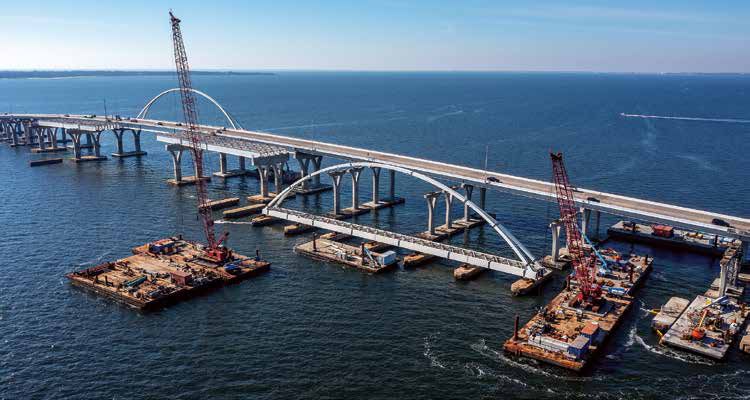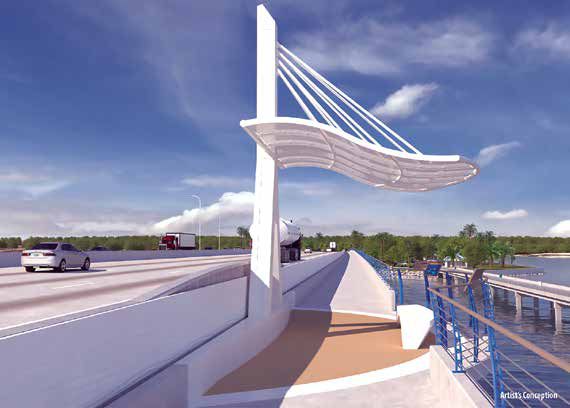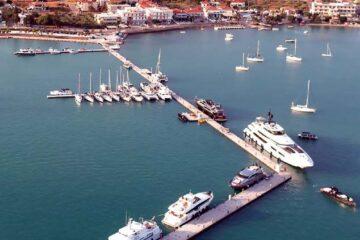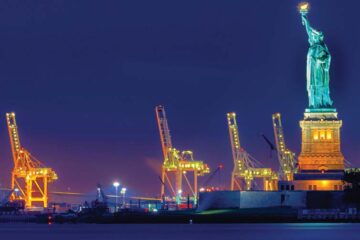Construction is rapidly proceeding for the storm-delayed Pensacola Bay Bridge, a major transportation project on the northern Gulf of Mexico coast. The bridge connects the Florida cities of Pensacola and Gulf Breeze. U.S. 98, which runs over the bridge, is a significant transportation corridor for the region and a primary hurricane evacuation route.
The first bridge across Pensacola Bay opened in 1931 as a two-lane drawbridge and was replaced several times, the last occurring in 1960. As its 50-year lifespan was reached, the Florida Department of Transportation (FDOT) put out bids for it replacement. The contract was awarded to Skanska and in 2017, the company began construction of a two-span replacement. The westbound side and pedestrian crossing opened in August 2020.
(Editor’s note: Although the Pensacola Bay Bridge runs from north to south by the compass, the road it carries has east-west numbers, U.S. Highway 98 and Florida State Road 30. Thus, the “westbound” side of the bridge runs north by the compass from Gulf Breeze to Pensacola.)
Weeks later, however, Hurricane Sally struck the bay. On September 15, 2020, a barge broke loose and was stuck under the bridge, requiring closure of the span. The next day, a crane was blown down on the bridge, knocking much of the span in the Pensacola Bay and putting the span fully out of commission. When complete, the $427 million project will increase safety and improve traffic flow for the estimated 58,000 drivers who travel the bridge each day.
The eventual eastbound span of the new Pensacola Bay Bridge opened in September 2019. At that time, two lanes of east and two lanes of westbound traffic were transitioned to the bridge. The traffic shift is allowing crews to continue demolition of the former bridge and construct the new westbound structure. When work is complete the new Pensacola Bay Bridge will have three 12-foot travel lanes, 10-foot inside and outside shoulders, and a 10-foot, multi-use path for pedestrians and bicyclists.
Architectural elements will include a central arch that will add aesthetic distinction to the bridge and provide primary structural support for the multiuse paths. Shaded observation points will be constructed along the paths with benches that will allow users space to rest, reflect, and enjoy the panoramic vistas of Pensacola Bay.
Recreational facilities on both the Gulf Breeze and Pensacola shorelines will feature boat launches, picnic areas, and free parking. The fishing pier on the Pensacola side of the bay will remain in place once the new bridge is completed.
Marine traffic will be enhanced by a center span that increases vertical clearance from 50 to 65 feet. The width of the navigational channel will also be increased from 125 to 150 feet.
In February 2022, construction moved from the navigational channel toward the Pensacola shoreline. The construction team reported pile driving as 95 percent complete, trophy pieces at 90 percent, and deck construction at 50 percent complete for the westbound span.
The team also set the triple steel beam sections near the navigational channel for the westbound bridge.
Construction reached a major project milestone March 10 as the arch was erected on the westbound bridge. The arch will become an element of architectural distinction for the project and provide structural support for the 10-foot-wide multi-use path adjacent to the westbound bridge. Each of the two arches weighs 800,000 pounds, nearly twice the weight of the Statue of Liberty, and is tall as an eight-story building. Each arch consists of structural steel plates that were cut to shape and welded together. The strands that extend from the top of the arch to the bottom deck are made of high-strength steel and covered by a protective sheath.
By April 22, construction crews completed pile driving for both the east and westbound bridges. This project required a total of 2,252 piles, each one being brought by barge to the project site from the dedicated concrete casting yard on Bayou Chico. The piles range in length from 60 to 210 feet and weigh between 54,000 and 189,000 pounds each. They’ve been driven into the bay floor to depths of 60 to 180 feet to provide the foundation for the $430 million structure.
With pile driving complete, crews continued to set trophy pieces and beams for the remaining portions of the westbound bridge, pour the concrete for the bridge decks and completing the multi-use paths that will be adjacent to the travel lanes on both bridges.
By April 29, the Pensacola Bay Bridge multi-use path re-opened. The ten-foot-wide lighted path includes six scenic overlooks, each equipped with shaded seating areas that provide panoramic views of Pensacola Bay. The path is intended for bicyclists and pedestrians.
The entire project is currently estimated for completion later this year.
Republished from Marine Construction Magazine Issue V, 2022












